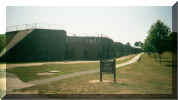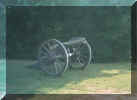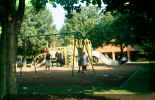Fort Mott: Sentinel on the Delaware
By Brendan Schurr
Associated Press
FORT MOTT — In a curve of
coastline on New Jersey's south
west comer stands a military fort
that in the 1800s was considered by
the federal government to be crucial
in protecting the Delaware River
from attack.
Fort Mott, along with Fort Delaware on Pea Patch Island in the
middle of the river and Fort DuPont
in Delaware, was built to protect
industries and shipping along the
river. Any hostile ship that rounded
the bend, about 30 miles from the
river's mouth, would be a sitting
target for soldiers at the three forts.
 Later in the century, concerned
that the country's coastlines were
vulnerable and fearing attack from
the Spanish in the Spanish-American War, President Grover Cleveland ordered defenses throughout
the nation strengthened. As part of
that effort, earthen embankments
reinforced with 35 feet of concrete
were built at Fort Mott to look like
natural hills, and huge "disappearing guns" were installed.
Later in the century, concerned
that the country's coastlines were
vulnerable and fearing attack from
the Spanish in the Spanish-American War, President Grover Cleveland ordered defenses throughout
the nation strengthened. As part of
that effort, earthen embankments
reinforced with 35 feet of concrete
were built at Fort Mott to look like
natural hills, and huge "disappearing guns" were installed.
While it never came under attack, Fort Mott remained a working
military installation until after
World War II. "It's better to have it
and not use it than to need it and
not have it, "Andres Grant, a visitor
services assistant, said while conducting a tour of the fort on a recent
afternoon.
 Visitors today can learn how the
guns were loaded, fired and reloaded, almost entirely out of the
view of river traffic, and can take a
walking tour of the gun emplacements, the magazine where gunpowder was stored and hoisted by
crank to the weapons above and the
soldiers' perpetually self-flushing
toilets. Of the 33 buildings that
once stood on the 104-acre fort, including a bakery, a hospital, a carpenter's shop and a theater, only a
few remain; most were dismantled
or moved. A bright yellow building
that was the post headquarters now
serves as a visitor center and gift
shop, and the jail cells have been
converted to a guard house and
public restrooms.
Visitors today can learn how the
guns were loaded, fired and reloaded, almost entirely out of the
view of river traffic, and can take a
walking tour of the gun emplacements, the magazine where gunpowder was stored and hoisted by
crank to the weapons above and the
soldiers' perpetually self-flushing
toilets. Of the 33 buildings that
once stood on the 104-acre fort, including a bakery, a hospital, a carpenter's shop and a theater, only a
few remain; most were dismantled
or moved. A bright yellow building
that was the post headquarters now
serves as a visitor center and gift
shop, and the jail cells have been
converted to a guard house and
public restrooms.
 The fort is named for Maj. Gen.
Gershom Mott, a Bordentown native who was a decorated veteran of
the Mexican-American and Civil
wars. Mott also served as state treasurer and supervisor of the state
prison system. The "disappearing
guns" were the main weapons and
most significant feature of Fort
Mott. The six rifles — three of
which were 10 inches in diameter
and three of which were 1 foot in
diameter — were mounted on cartridges behind the sloping concrete
and earthen embankments. The
guns, with 25-foot-long barrels,
were loaded while in the "down" or
"recoiled" position by a team of 30
soldiers. The shells for the smaller
guns weighed 617 pounds, while the
12-inch guns required 1,000-pound
shells.
The fort is named for Maj. Gen.
Gershom Mott, a Bordentown native who was a decorated veteran of
the Mexican-American and Civil
wars. Mott also served as state treasurer and supervisor of the state
prison system. The "disappearing
guns" were the main weapons and
most significant feature of Fort
Mott. The six rifles — three of
which were 10 inches in diameter
and three of which were 1 foot in
diameter — were mounted on cartridges behind the sloping concrete
and earthen embankments. The
guns, with 25-foot-long barrels,
were loaded while in the "down" or
"recoiled" position by a team of 30
soldiers. The shells for the smaller
guns weighed 617 pounds, while the
12-inch guns required 1,000-pound
shells.
 After a gun was loaded, a heavy
lead counterweight was released
and dropped into a pit below, elevating the gun above the embankment for firing. Once fired, the gun
recoiled, disappeared below the wall
and was camouflaged again. The
guns used so much gunpowder that
the loud blasts could be heard for
miles and disrupted local farm life.
After a gun was loaded, a heavy
lead counterweight was released
and dropped into a pit below, elevating the gun above the embankment for firing. Once fired, the gun
recoiled, disappeared below the wall
and was camouflaged again. The
guns used so much gunpowder that
the loud blasts could be heard for
miles and disrupted local farm life.
 Visitors to Fort Mott can take a
ferry to Fort Delaware to learn
about its place in Civil War history.
Ferries operate Wednesday through
Sunday. Visitors also can tour the
small Finn's Point National Cemetery, accessible via Fort Mott's main
entrance. It contains the graves of
2,436 Confederate soldiers who died
while prisoners of war at Fort
Delaware. More than 130 Union
soldiers who died while serving as
guards at the fort prison also are
buried on the federally owned plot.
Visitors to Fort Mott can take a
ferry to Fort Delaware to learn
about its place in Civil War history.
Ferries operate Wednesday through
Sunday. Visitors also can tour the
small Finn's Point National Cemetery, accessible via Fort Mott's main
entrance. It contains the graves of
2,436 Confederate soldiers who died
while prisoners of war at Fort
Delaware. More than 130 Union
soldiers who died while serving as
guards at the fort prison also are
buried on the federally owned plot.
Fort Delaware, which was overcrowded and had a high water
table, was unsuitable for burial, so
corpses were transported to Finn's
Point, 1/2 miles away.
 Finn's Point made headlines in
1997, when murderer Andrew Cunanan passed through while
federal officials. The Fort Mott visitor center also serves as the welcome center for the Delsea
region of
the state's Coastal Heritage Trail.
The trail, which begins at Fort Mott
and runs south along the Delaware
River then north along the Atlantic
Coast, highlights places that are
part of New Jersey's maritime history, coastal habitats and
migration.
Finn's Point made headlines in
1997, when murderer Andrew Cunanan passed through while
federal officials. The Fort Mott visitor center also serves as the welcome center for the Delsea
region of
the state's Coastal Heritage Trail.
The trail, which begins at Fort Mott
and runs south along the Delaware
River then north along the Atlantic
Coast, highlights places that are
part of New Jersey's maritime history, coastal habitats and
migration.

Fort Mott State Park
454 Fort Mott Road, Pennsville, NJ 08070
(856) 935-3218
Web site: http://www.state.nj.us/dep/forestry/parks/fortmot.htm
You can also learn more about Fort Mott and the New Jersey Heritage
Trail by clicking here.
Directions:
Turnpike south to last exit onto Rt. 295. Go east on Rt.49 and take six traffic light right onto Fort Mott Rd. Go 5 mi. to park on right.
 Activities:
Activities:
Self guided walking tours, picnic area, pavilion with restrooms, welcome center.

This beautiful 106-acre park was originally built at Finn's Point as part of
the federal government's plan for defending the Delaware River. It was part of
an elaborate system of hundreds of fortifications designed to protect American
harbors against foreign attack. Based on a plan devised in 1794, most of these
forts were built in the 19th century and later modified to keep up with
technological advances.
Fortifications as they exist here today were built in 1896 in anticipation of
the Spanish-American War. Visitors can take a Self-Guided Tour, aided by an
interpretive map, and explore the remnants of a once-important military
installation.
 Though the fort was disarmed long ago and the guns are gone, the various
emplacements and magazines lining the 750 foot-long parapet are impressive to see.
Aided by the map, visitors can easily piece together what this fort was like in
its day.
Though the fort was disarmed long ago and the guns are gone, the various
emplacements and magazines lining the 750 foot-long parapet are impressive to see.
Aided by the map, visitors can easily piece together what this fort was like in
its day.
The parapet is composed of poured concrete, its wall thirty-five feet thick.
Combined with an additional thirty feet of sand and earth, the walls concealed
and protected guns and crew from seaward attack. In all there are eleven stops
on the tour, each highlighting some unique feature of the fort.
The Visitor Center features exhibits on New Jersey's Coastal Heritage Trail
and the History of Fort Mott.
Groups, including School Groups, can enjoy an educational Guided Tour.
Call to discuss your group's needs with park staff.
 Copyright © 2001-
, Terry Muse
Copyright © 2001-
, Terry Muse
Revised: October 8, 2001
URL: http://coastalheritagetrail.tripod.com
Contact: Terry Muse
Coastal Heritage Trail | Delsea Region
 Later in the century, concerned
that the country's coastlines were
vulnerable and fearing attack from
the Spanish in the Spanish-American War, President Grover Cleveland ordered defenses throughout
the nation strengthened. As part of
that effort, earthen embankments
reinforced with 35 feet of concrete
were built at Fort Mott to look like
natural hills, and huge "disappearing guns" were installed.
Later in the century, concerned
that the country's coastlines were
vulnerable and fearing attack from
the Spanish in the Spanish-American War, President Grover Cleveland ordered defenses throughout
the nation strengthened. As part of
that effort, earthen embankments
reinforced with 35 feet of concrete
were built at Fort Mott to look like
natural hills, and huge "disappearing guns" were installed.







